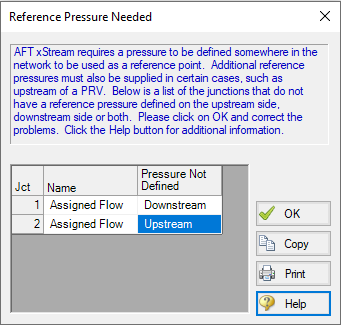Role of Pressure Junctions and How They Work
In modeling a generalized pipe network, it is possible to construct models that do not have a unique solution. A common occurrence of this is when a model contains one or more sections which are completely bounded by known flow rates. The simplest example is the system shown in Figure 1. In AFT xStream terms, the system has two assigned flow junctions.

Figure 1: Model with two assigned flows. This model does not have a unique solution
Obviously, the flow in the pipe is known. But what is the pressure at the inlet? At the outlet? It cannot be determined because there is no reference pressure. The reference pressure is that pressure from which other pressures in the system are derived. There can be more than one reference pressure, but there always has to be at least one.
The model in Figure 1 can be built with AFT xStream and if you try and run this model, AFT xStream will inform you that it cannot run it because of the lack of a reference pressure (Figure 2). In AFT xStream there are several junctions that can act as a reference pressure: the tank, assigned pressure, valve (with the exit valve option), and pressure control valves.
When you try and run a model that has one or more sections completely bounded by known flows (or Flow Control Valves or Compressors/fans operating in assigned flow mode), the Need Reference Pressure window (shown below) is displayed. This window informs you which junctions bound the sections where a reference pressure is needed to obtain a unique solution.
In multi-pipe systems there are a host of other possibilities that present themselves. All other configuration possibilities which lack a reference pressure ultimately boil down to the same problem that exists in Figure 1.
See Role of Pressure Junctions - Detailed Discussion (Long) for more information.

Figure 2: AFT xStream message when you try to run a model without sufficient reference pressures
How Pressure Junctions Work
Pressure junctions (e.g., Tanks or Assigned Pressures) in AFT xStream are an infinite source or sink of fluid. This means that they can draw or discharge as much fluid as is necessary to maintain the specified pressure. Some engineers have difficulty grasping this concept, and misuse pressure junctions in AFT xStream. This section offers a physical example of how pressure junctions work to clarify for those having difficulty with the concept.
Consider the physical system shown in Figure 1. This system compresses air from a low pressure supply tank to a high pressure discharge tank.

Figure 1: Physical compressor system to transfer air from low pressure tank (J1) to high pressure discharge tank (J2)
An engineer is tasked with sizing the compressor for this system. The engineer has an idea of the discharge pressure needed for the compressor, and builds an AFT xStream model as shown in Figure 2. The Figure 2 model is attempting to represent the physical system in Figure 1, but it in fact represents the physical system in Figure 3.

Figure 2: Model to size compressor attempting to represent system in Figure 1, but actually represents the system in Figure 3

Figure 3: Physical system represented by model in Figure 2
Why? Because the tank junction (J4), which is an infinite source of fluid, has been located between the compressor (J3) and the discharge tank (J2). The J4 tank isolates the supply tank and compressor (J1 and J3) from the discharge tank (J2). The J4 tank is very much like placing the atmosphere between the supply and discharge piping.
If the engineer changes the pressure in J4, it is like changing the atmospheric pressure. It will change the flow rate in the pipes, but no matter how high the pressure of J4, it does not change the fact that the compression system is isolated from the discharge tank. The flow rate in the piping from J4 to J2 is entirely dependent on the difference in pressures between J2 and J4, and is not influenced by the J3 compressor in any way.
How then should the physical system in Figure 1 be modeled? It should be modeled as shown in Figure 4.

Figure 4: Proper model of physical system shown in Figure 1
If the goal is to size the compressor at J3, the model is Figure 4 can be used with the compressor modeled as a fixed flow compressor.
Related Blogs
Reference Pressure Needed: Where It Comes from and How to Address it



